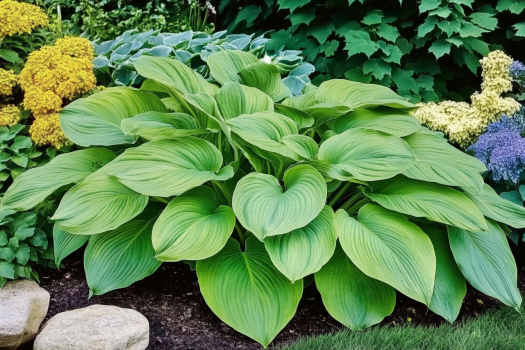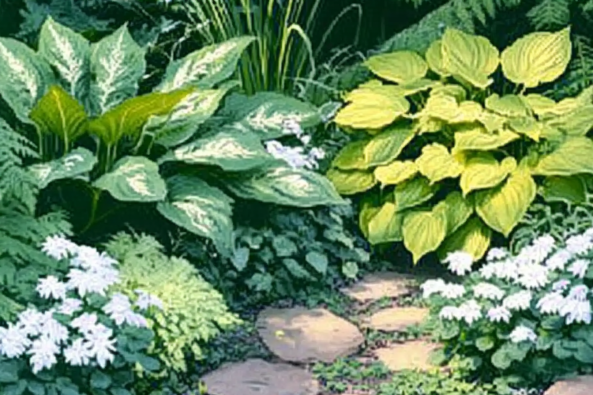Why Choose Low Maintenance Shade Plants?
Shade-loving plants are an excellent addition to any garden, offering beauty with minimal effort. Whether you have a fully shaded yard or areas beneath large trees, these plants can thrive and provide lush greenery without constant upkeep.
The Benefits of Shade-Loving Plants in Your Garden
- Reduce maintenance needs – No need for excessive watering or pruning.
- Enhance biodiversity – Provide habitats for beneficial insects and wildlife.
- Improve soil quality – Many shade plants enrich soil and prevent erosion.
Best Spots to Plant Shade Perennials
- Underneath trees and shrubs
- Along north-facing walls
- Shady patio corners and pathways
Understanding Shade Levels for Plant Selection
Full Shade vs. Partial Shade
- Full shade – Less than three hours of direct sunlight per day.
- Partial shade – Three to six hours of filtered or indirect sunlight.
Dappled Shade and Deep Shade
- Dappled shade – Light filters through trees, creating a shifting sun pattern.
- Deep shade – No direct sunlight, usually found under dense tree canopies.
Best Soil Conditions for Shade Gardens
- Rich, well-draining soil with organic matter
- Moist but not waterlogged soil
- Mulch to retain moisture and suppress weeds
Top 12 Low Maintenance Shade Plants for a Beautiful Garden
1. Hosta

- Best varieties for different shade levels – ‘Sum and Substance’ for partial shade, ‘Blue Mouse Ears’ for full shade.
- Companion planting ideas – Pairs well with ferns, astilbe, and bleeding heart.
2. Coral Bells (Heuchera)
- Stunning foliage colors – Available in shades of red, purple, and lime green.
- Low water and maintenance needs – Drought-tolerant once established.
3. Bleeding Heart (Dicentra)
- Unique flowers and seasonal appeal – Delicate heart-shaped blooms in spring.
- Best growing conditions – Prefers cool, moist soil with good drainage.
4. Hydrangea (Shade-Tolerant Varieties)
- Choosing between mophead, lacecap, and panicle types – Mopheads prefer more shade; panicles tolerate sun.
- Low-care tips – Water deeply but infrequently; prune in early spring.
5. Ferns
- Best fern varieties for shade gardens – Ostrich fern, Japanese painted fern, maidenhair fern.
- Ideal placement – Borders, under trees, or along pathways.
6. Astilbe
- Feathery blooms that add texture – Available in pink, red, and white.
- Best soil and watering practices – Moist, well-draining soil with organic compost.
7. Japanese Painted Fern
- How to use colorful ferns in shade gardens – Adds striking silver, purple, and green tones.
- Pairing with other shade-loving perennials – Works well with hostas and coral bells.
8. Woodland Phlox
- Fragrant ground cover for partial shade – Attracts pollinators and adds color in spring.
- Seasonal flowering and care tips – Blooms early; trim back after flowering.
9. Lily of the Valley
- Hardy and fragrant ground cover – Spreads easily, forming dense colonies.
- How to control spreading – Use barriers or plant in containers.
10. Solomon’s Seal
- Elegant arching stems with white flowers – Adds height and structure.
- Drought tolerance and long-term maintenance – Thrives in dry shade once established.
11. Creeping Jenny

- Fast-growing ground cover for erosion control – Ideal for filling gaps between stepping stones.
- Where to plant it for best results – Use in hanging baskets, along edges, or around ponds.
12. Deadnettle (Lamium)
- Colorful foliage for low-light gardens – Features silver and green leaves with small blooms.
- How to prevent overgrowth – Prune lightly to control spreading.
Tips for Planting and Maintaining Shade Gardens
Planting Tips
- Choosing the right soil and mulch – Compost-enriched soil with organic mulch.
- Understanding plant spacing and growth habits – Avoid overcrowding to promote airflow.
- Best times of the year to plant shade perennials – Early spring or fall.
Maintenance Tips
- Watering strategies for shade gardens – Water in the morning to prevent mold growth.
- Preventing common pests and diseases – Watch for slugs and fungal infections.
- Minimal pruning and fertilizing techniques – Use slow-release fertilizers sparingly.
Common Mistakes to Avoid When Growing Shade Plants
- Overwatering or poor drainage issues – Ensure soil is well-draining.
- Choosing plants that require too much sunlight – Match plants to shade levels.
- Ignoring soil quality and organic matter – Regularly amend soil with compost.
More Ideas for a Low Maintenance Garden
Best Ground Cover Plants for Shady Areas
Ground covers like creeping phlox and ajuga minimize weeding and erosion.
Low-Maintenance Perennials That Thrive in Any Climate
Discover hardy perennials that can withstand diverse weather conditions.
Shade Garden Layout Ideas for Small Spaces
Maximize small shady areas with layered planting and vertical garden techniques.
Related Articles
- 10 Best Perennials for Low-Light Gardens
- How to Create a Low-Maintenance Backyard Oasis
- The Best Plants for Year-Round Color in Shade Gardens
By incorporating these low-maintenance shade plants, you can create a lush, vibrant garden that thrives effortlessly in shaded areas.

